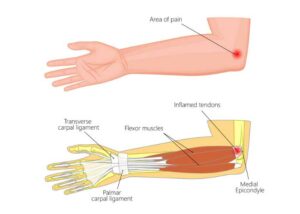Golfer’s Elbow
Last Updated on August 12, 2024 by The SportsMD Editors
Golfers elbow is an inflammatory condition on the inner side of your elbow, where the tendons of your forearm muscles attach to the bony bump on the inside of your elbow. The pain may spread into your forearm and wrist.
And it’s not limited to golfers. Tennis players and others who repeatedly use their wrists or clench their fingers also can develop golfer’s elbow.
Golfer’s elbow location
The anterior forearm contains several muscles that are involved with flexing the fingers and thumb, and flexing and pronating the wrist. The tendons of these muscles come together in a common tendinous sheath which is inserted into the medial epicondyle of the humerus at the elbow joint. In response to minor injury, or sometimes for no obvious reason at all, this point of insertion becomes inflamed and can cause pain and discomfort. Golfer’s elbow location is shown in this image.
and thumb, and flexing and pronating the wrist. The tendons of these muscles come together in a common tendinous sheath which is inserted into the medial epicondyle of the humerus at the elbow joint. In response to minor injury, or sometimes for no obvious reason at all, this point of insertion becomes inflamed and can cause pain and discomfort. Golfer’s elbow location is shown in this image.
Can I have golfer’s elbow even if I don’t play golf?
This condition is named golfer’s elbow because this area is stressed when making a golf swing; however, the majority of the people who suffer from this condition do not play golf. Many athletes who participate in overhead athletics (baseball, javelin, tennis) can develop this condition. Many people who suffer from this condition are not involved in athletics at all.
Symptoms of golfer’s elbow
Focal pain located on the inside of the elbow near the medial epicondyle that is usually worse with activity. Pain with resisted forearm flexion is also consistent with golfer’s elbow.
Prevention
Unfortunately there not much anyone can do to prevent golfer’s elbow. It is usually associated with minor trauma or overuse. Athletes that participate in overhead sports should focus on stretching and strengthening their forearm musculature.
Treatment
Initially, a period of ice, over the counter anti-inflammatory medication, and avoidance of provocative activities can often alleviate the majority of symptoms. Persistent pain can be treated with an injection into and around the inflamed and tender area with a long-acting steroid agent. Initially, the injection can cause an exacerbation of symptoms for a period of 24-48 hours; however, most patients experience a significant reduction in pain over the ensuing weeks.
Can physical therapy help?
Physical therapy can play role in treating golfer’s elbow by focusing on local pain control and eliminating any swelling. A physical therapist may use ultrasound or other modalities to help heal the damage of an injury. Additionally, they may prescribe flexibility and strengthening exercises to allow you to return to the activity. However, over-strengthening will often exacerbate symptoms. Therefore, a period of rest is usually the best initial treatment.
How many injections can I have?
Some patients experience a return of symptoms after a long period of pain relief after the steroid injection. Multiple injections in a short period of time can be very detrimental and can actually worsen injury to the tendons. Therefore, more than 2 injections in a given year should be avoided.
Do I need surgery to fix the problem?
In a very small number of cases, patients can experience persistent pain and discomfort despite rest, medication, and injections. In such cases, a small surgery can be performed to remove the damaged portion of the tendon and repair the remaining tendon back to the bone. The procedure takes about 30 minutes and patients can go home the same day. After a few weeks of therapy, most patients return to full activity in approximately 6 -8 weeks.
Can Telemedicine Help?
Telemedicine is gaining popularity because it can help bring you and the doctor together quicker and more efficiently. It is particularly well suited for sports injuries and facilitating the diagnoses and treatment of those injuries. Learn more about speaking with a sports specialized provider via SportsMD’s 24/7 Telemedicine Service.
References
- Injuries and overuse syndromes in golf. Gosheger G, Liem D, Ludwig K, Greshake O, Winkelmann W. Am J Sports Med. 2003 May-Jun;31(3):438-43.
- Overuse injuries of the upper extremity in golf.
McCarroll JR. Clin Sports Med. 2001 Jul;20(3):469-79

